Aspatria RUFC - the appliance of science

Aspatria is a community of just under 3,000 in Cumbria, midway between Workington and Carlisle, but closer to the Solway Firth. This is about as far north as you can go in England before you start singing Flower of Scotland.
For such a small and somewhat isolated community, it is perhaps surprising to find a thriving rugby union club. Chairman John Heyworth has dedicated much of his efforts into ensuring that club development of its facilities is dedicated to sustaining the continuing success of the club both on and off the field.
John joined the Aspatria RUFC Ltd committee as a volunteer back in 1990, and became chairman in 2000 following retirement from his role as a company director in the paperboard manufacturing industry. "One of my responsibilities was the specification, justification and project management of capital expenditure items of about £20m/pa," he explains; a role that provided valuable experience in securing funding for the rugby club.
He is also chair of Cumbria RFU Ltd., as well as being the county's RFU Facilities Coordinator.
Having attained a BSc Hons at the University of Manchester Institute of Science and Technology, John went into the paperboard industry gradually progressing up the management tree. Since retirement his considerable management experience is being put to good use in his current roles. But how did he get involved in groundsmanship?
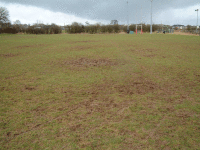
"I reasoned that some opinions were not scientifically sound, so volunteered to get myself trained in the appropriate science and technology, then apply said knowledge to our pitches. I have, however, made it my business to establish expert contacts in the industry, for example with Keith Kent, Head Groundsman at RFU Twickenham."
The site covers a total of five hectares; three of which are grassed areas, with the rest being car parks, clubhouse, grandstand (with gymnasium and changing rooms) and a hard covered all weather area.
"As Chairman, I have to convince the committee, and particularly our Hon. Treasurer, of the need to spend annual budgeted expenditure on pitch maintenance, along with many other items. I have also been instrumental in raising grant funding from the RFF (the RFU's funding arm), Sport England and various other funding bodies for capital expenditure on maintenance equipment and storage, new floodlights for the training pitches and the 1st XV pitch, along with drainage for the training pitches. To date, this has totalled more than £150k since 2003."

Those volunteers include a retired head teacher who marks out the pitches, an electrical engineer who looks after all electrical issues and helps with all tractor driving tasks - mowing, deep tine aeration, fertiliser spreading, sand topdressing, overseeding, spraying etc. - and a retired mechanical engineer who does all the odd jobs. "I am, though, the main specifier and contact with agronomists and contractors for most, but not all, disciplines," he confirms.
By now, John's passion for the club will be evident and he goes on to outline the pitch problems that got him involved initially. "The soil profile is a clay based loam rootzone, varying in depth from as little as 150mm to as much as 500mm, dependent on location. The subsoil is boulder clay."
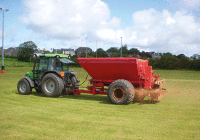
"The contractor also created a 'slight slope' on the 1st team pitch, which would be good, except that it slopes back towards the slope from which it was cut! The photographs of the partially flooded pitch shows this clearly. This happens every time it rains heavily and slows the rate of drainage of the whole pitch considerably" he bemoans. "The solution will cost upwards of £50k. I will be applying to Sport England for grant funding for this pitch in the near future."
"This pitch has, naturally, been the focus of our attention for many years as it is where most of our matches are played," continues John.
"We have three pitches, but only the 1st XV pitch is full RU size; the others are smaller and double as training pitches. Local rugby league and football clubs use our training pitches for their training and the 1st XV pitch for league matches and occasional finals. Social cricket is also played on this area in the summer, but there is no true wicket, only a closely mown strip."
John goes on to explain that all the pitches are soil based, but have been topdressed with sand regularly since 2003; the first team pitch having received the heaviest tonnage and the most aeration.
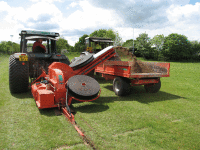
"The 1st XV pitch has had two sets of agricultural type drains installed since it was constructed, neither of which are effective enough in terms of their ability to drain quickly, partly owing to their depth and being spaced too far apart, and partly owing to the soil construction and the surface slope which runs against the drains."
"Sand slits were installed in some areas about ten years ago, but these remain the wettest part of the pitch. New, closely spaced sports drains are required to give the club any dependable chance of fulfilling fixtures following or during heavy rain. We have fulfilled many fixtures when the pitch has been waterlogged, with resultant compaction and cutting up, which just makes the groundstaff's job more difficult. The pressure to play on waterlogged pitches is always commercial, so I am always ambivalent, having shared responsibility for income streams in my role as Chairman."
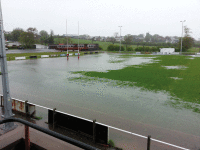
"The most recent flood of 18th May 2013 will go down in Cumbrian rugby history," observes John. "A county rugby semi-final was scheduled for this day between Surrey and Cumbria. The victors would go to Twickenham for the final. It started raining very heavily about midnight during the night prior. By 10.00am on the morning of the match, the pitch was 90% covered in water up to 250mm deep. Knowing the forecast was for the rain to stop at about 2.00pm, a decision was made to attempt to pump off the water using agricultural slurry tankers and portable pumps. To cut a long story short, enough was pumped off to enable kick off at about 4.00pm. Cumbria won and we went to Twickenham the following weekend, but sadly lost a close match."
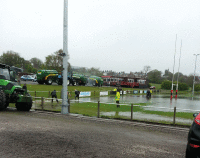
"We have an annual maintenance schedule - which we adhere to when the weather is kind enough to allow it!" exclaims John. "The team of volunteers do it all, unless we happen to have secured some RFU funding!"
"The grass is cut at about 75mm for winter matches using a Trimax triple rotary, 2180mm wide, towed behind our Massey Ferguson 1560 tractor, which was purchased new in 2003. If matches are in May, and coincide with good conditions then we might bring it down to 40-50mm, and also in August and early September if the weather has been kind. But, we'll normally be back up at 75mm by mid September."
"We generally stripe in parallel lines lengthwise, but sometimes across if the occasion, time and pitch condition allow. We don't mow after matches, except in the fast growing season in May and June, but we ensure that we mow in alternate directions every four to five days."
"We carry out aeration using RFU Cumbria's SR75 Soil Reliever as often as weather, pitch conditions and my time allow, but at least four times between April and September. This equipment is housed at the club for hire to any Cumbrian Rugby Union clubs at discounted rates - and anybody else at slightly higher rates. Transport is the prohibitive issue in Cumbria."
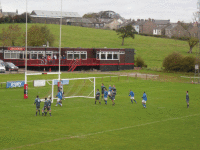
"We are able to borrow a tractor-towed hybrid Dutch disc overseeder from a local farmer on occasion," continues John, "but one of the most used machines, apart from the tractor and mower, is our Sisis Quadraplay which is equipped with adjustable height rotary spiker, spring tine harrow, roller and brush, which we use frequently, in that order, to flatten divots and, in the off season, to brush in sand topdressing. Again, we are fortunate to borrow a five tonne topdresser from a local agricultural contractor, but this is pulled by RFU Cumbria's SDF Agroplus 65 tractor. Sand is obtained from a local quarry owned by a club sponsor."
A Vicon 300kg fertiliser spreader completes the equipment list. This is used a couple of times a year, occasionally more if the sward requires.
Two volunteers are trained to operate the tractor and associated equipment, one being John. Very occasionally, players or students may operate them under strict supervision.

On a site that is "normally breezy with occasional 'horizontal' rain", are there any other issues John has to contend with? "The area immediately in front of the stand remains frozen for longer periods, and rabbits and moles come in from adjacent fields. I have a 'friendly' pest exterminator who traps moles and shoots rabbits. Anti-rabbit fence has been installed by Network Rail along the adjacent railway embankment, which is basically just a warren!"
As is often the case with volunteer run clubs - only the bar manager and rugby coach are paid part-time - there is always much to do. "Our top priority is to replace the leaking, thirty-year old flat roof on the clubhouse with a pitched design. Our problem, as always, is lack of capital, but we are applying to Sport England for funding. We are also working with the RFU on upgrading the interior of the clubhouse using the RFU's Social Spaces programme. This project is expected to cost in the region of £30,000."
"We would also like to install drainage on our 1st XV pitch using the same system as on the training pitches. Turfdry have provided a budget cost of £48,000."

Clearly, John is something of an expert when it comes to sourcing funding, and it should be remembered that the club is run for the benefit of the wider community. This year, they will host their first rock concert as well as the annual town gala.
New technology has improved the groundsman's lot in the past ten years, but John believes that the industry, in general, is underrated in terms of its contribution to sport, with the possible exception of golf and Premiership level stadia.
In recognition of his work, John was awarded Volunteer Sports Groundsman of the Year in 2013 and, in typically humble fashion, dedicated his award to his club's volunteers and committee, whilst also thanking the RFU for their investment.
RFU Head Groundsman, Keith Kent, was full of admiration for John: "This is an outstanding achievement and is richly deserved by John. I hope this award shows our other clubs how much can be achieved through grit, determination and a lot of aeration! The RFU and the whole of Cumbria can be very proud of John."
And is there anything else on John's wish list? "Someone to take over from me and a better club tractor. The geriatric volunteer drivers are very stiff when we finish a day's work hunched up on our tractor."



